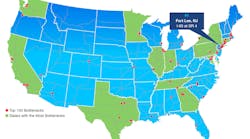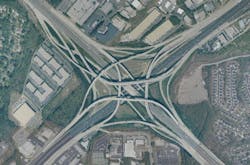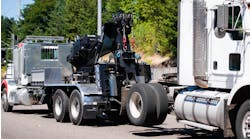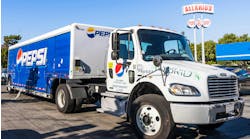The New York City metro area has supplanted Atlanta as the site of the worst highway congestion in the U.S.
For the previous three years, Atlanta’s “Spaghetti Junction” was rated the worst bottleneck on the nation’s highways, according to the American Transportation Research Institute’s (ATRI) annual Top Truck Bottleneck List. But the 2019 list, which was released on Tuesday morning, named the intersection of Interstate 95 and State Route 4 in Fort Lee, NJ, – an entrance into New York City – as the worst freight bottleneck in the U.S. The location is in the shadows of the George Washington Bridge, which is where many vehicles slowly creep into Manhattan along I-95.
This is the first time since 2014 that the Fort Lee junction is No. 1 on the list. It was ranked No. 2 in 2018. Helping it reclaim the top spot on the bottleneck list is the construction currently taking place on the George Washington Bridge during off hours as the Port Authority of New York and New Jersey works to replace suspension cables.
The Fort Lee congestion is just one of 10 bottlenecks in the New York City tri-state area of New York, New Jersey and Connecticut cited in ATRI's top 100 bottlenecks in the U.S.
The 2019 list assesses the level of truck-oriented congestion at 300 locations on the national highway system. The analysis, based on truck GPS data from nearly 1 million heavy-duty trucks uses several customized software applications and analysis methods, along with terabytes of data from trucking operations to produce a congestion impact ranking for each location.
That congestion costs the trucking industry $74.5 billion annually, according to ATRI, and the industry loses 1.2 billion hours of productivity while trucks sit in traffic across the U.S. The research group says that is equivalent to 425,533 truck drivers sitting idle for an entire year.
ATRI’s truck GPS data is used to support the USDOT’s freight mobility initiatives. The locations detailed in this latest ATRI list represent the top 100 congested locations.
“Congestion is a persistent issue for our industry and our company specifically,” said Rich McArdle, president of UPS Freight. “For UPS, if all of our vehicles are delayed just five minutes a day, every day, it costs our company $114 million a year. In order to combat congestion, many companies must plan operational redundancies to meet their customer needs. Using data like ATRI’s bottleneck report can help both companies and elected officials to make more informed decisions.”
Here is a look at the Top 10 worst freight bottlenecks in the U.S., according to ATRI:
- Fort Lee, NJ: I-95 at SR 4
- Atlanta: I-285 at I-85 (North)
- Atlanta: I-75 at I-285 (North)
- Los Angeles: SR 60 at SR 57
- Houston: I-45 at I-69/US 59
- Cincinnati: I-71 at I-75
- Chicago: I-290 at I-90/I-94
- Nashville: I-24/I-40 at I-440 (East)
- Atlanta: I-20 at I-285 (West)
- Los Angeles: I-710 at I-105
You can view the top 100 worst bottlenecks on the ATRI website.
ATRI’s analysis found that year-over-year truck speeds across the top 10 locations dropped by an average of nearly 9% as congestion worsened along the nation’s busiest freight roadways.
“ATRI’s research shows us where the worst pain points are – but they are far from the only ones,” said Chris Spear, the American Trucking Associations president and CEO. “This report should be a wakeup call for elected leaders at all levels of government that we must act quickly to address our increasingly congested highway system “Without meaningful investment in our nation’s infrastructure, carriers will continue to endure billions of dollars in congestion-related costs – which results in a self-inflicted drag on our economy.”
Twelve states have at least four serious bottlenecks, according to ATRI:
- Texas: 13
- California: 7
- Connecticut: 6
- Georgia: 6
- Washington: 6
- Maryland/DC: 5
- Minnesota: 5
- New York: 5
- Pennsylvania: 5
- Illinois: 4
- Indiana: 4
- Tennessee: 4
ATRI has collected and processed truck GPS data since 2002. Using truck GPS data from nearly 1 million trucks, ATRI develops and monitors a series of key performance measures on the nation’s freight transportation system. ATRI now converts its truck GPS dataset into an ongoing analysis that is used to quantify the impact of traffic congestion on truck-borne freight at 300 specific locations.
The information provided through this effort assists decision-making by the private and public sectors by helping stakeholders better understand the severity of congestion and mobility constraints on the U.S. highway transportation system.
On a state and local level, this research can inform local investment decisions that can directly improve supply chain efficiency, according to ATRI.
In 2012, according to the research group, Illinois began reconstruction of the Chicago Circle Interchange (currently No. 7 on the list) after ATRI ranked it the nation’s No. 1 bottleneck. The $600 million project is expected to be completed by 2022.






